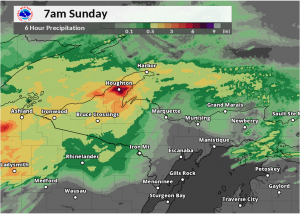
In the United States, flooding is a leading cause of natural disasters, with annual loss estimates of $54 billion. And while both urban and rural areas are vulnerable to flood hazards, most natural disaster resilience studies have focused on urban areas.
One such overlooked area is the western Upper Peninsula of Michigan and the rural communities bordering the south shores of Lake Superior, which are facing unprecedented challenges due to rising water levels.
Michigan Tech’s Dr. Thomas Oommen (GMES/ICC-DataS) is principal investigator of a newly-awarded $1 million, Phase Two National Science Foundation Civic Innovation Challenge grant that aims to build community-based solutions to these challenges that are sustainable, scalable, and transferrable to other vulnerable U.S. communities facing similar challenges. The project is titled, “Helping Rural Counties to Enhance Flooding and Coastal Disaster Resilience and Adaptation.”
Watch a video about the project here.
Working with Oommen on the project are co-PIs Guy Meadows (ME-EM), Timothy Havens (CS/ICC/GLRC), Melanie Kuber Watkins (CEGE), and Himanshu Grover (University of Washington).
Titled, “Helping Rural Counties to Enhance Flooding and Coastal Disaster Resilience and Adaptation,” the project will engage Michigan Tech researchers in developing new methods for improved flood hazard modeling that use remote sensing data and citizen scientists. The focus of the work is on Houghton, Baraga, and Ontonagon counties.
The project will update regional flood hazard maps at a significantly lower cost than traditional flood mapping approaches. “Using remote sensing data resources and citizen engagement (crowdsourcing), methods will be developed to address current data gaps for improved flood hazard modeling and visualization,” explains Oommen
“Public awareness and involvement is a crucial component of an overall hazard mitigation strategy,” says Oommen. “The involvement of civic agencies and the community through crowdsourcing will help raise the knowledge of the potential risks of hazards.”
And while this project focuses specifically on three U.P. counties, other communities will be invited to freely use the already-developed resources, data sets, and materials to engage their residents in resilience planning.
“Due to the limited availability of funding in rural communities to do this critical work, it is essential to pass along this project as a template to others,” says Oommen. “Further, the relationships developed during the project term will increase community and agency engagement for future hazard mitigation projects.”
Read the January 2021 announcement of the Michigan Tech’s Phase One NSF Civic Innovation Challenge Grant award here.
The National Science Foundation, In partnership with the U.S. Department of Homeland Security and the U.S. Department of Energy, awarded $15.9 million in Phase Two Civic Innovation Challenge grants. Teams comprise civic partners such as local, state, and tribal officials and non-profit and community leaders, who will conduct and evaluate ready-to-implement pilot projects that address community-identified challenges. (https://nsf.gov/news/news_summ.jsp?cntn_id=303451&org=NSF&from=news)
More information on these projects as well as other Stage 2 projects can be found at the https://nsfcivicinnovation.org/